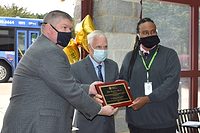Gaining Public Buy-In for Transit Safety Initiatives

We can all agree that the safer our public transit systems are, the better. Yet even a public that wants improved safety on public transportation systems isn’t always quick to get on board with safety initiatives.
In recent years, transit authorities have sought the help of passengers to be watchful and to report security concerns. The “See Something, Say Something” campaigns drive home the desired behavior. The rollouts of “See Something, Say Something” smartphone apps have taught us some valuable lessons about getting the public to buy in and join the effort to keep transit safe.
Perhaps the biggest lesson learned is the value of utilizing multiple media vehicles to get the word out about your safety initiative. Social media, the transit authority website and social media pages, text messaging, PR, media events, station and vehicle signage, video kiosks, etc. should all be part of the mix. Granted, there will be varying degrees of success with each method, but spreading your message through multiple channels increases the probability of rider engagement.
Nowadays, there is a direct correlation to the level of engagement with the use of technology. Hop on any public transit in the country, and you will see people on their smartphones, tablets or other devices. Fortunately, many initiatives are technology-based, and that can help with public buy-in. Even if the initiative does not involve technology, getting word out utilizing technologies – apps, text alerts, e-mails – is critical and should be part of the mix.
Conversely,“traditional” approaches like public information meetings, handing out flyers to passengers as they board or leave the bus or train, vehicle signage, etc. can also be effective as first point of contact or supplementing other messaging. Also, this helps ensure that those who may not be online will receive your message as well.
One point of emphasis in your messaging should be local schools, colleges and universities, both electronically and through traditional methods. Why? When it comes to the safety of their children, people are interested. When that message is spread through a school community, the speed at which your message is heard increases.
Repeating your message is a major key to public buy-in. A kickoff event, press conference, e-mail and text blast are fine to get things started but the message will need repetition to really take hold and get some buy-in. Repeat your message again and again.
You should also develop some metrics to gauge the effectiveness of your outreach. For example, how many e-mail blasts are enough to get the word out without alienating recipients? Clearly define how long your efforts will last in addition to gauging the effectiveness. For efforts that aren’t working as well as others, develop a Plan B. For ones that are working, stick with them.
Perhaps nothing engages the public more than early success stories. For example, let’s say there’s a solved criminal incident after your safety initiative begins. Share that with transit riders and the surrounding community through your various channels – website, PR, e-mail and text, social media sites, etc. People like to hear good news and will want to join an effort with a positive end result – a safer public transit system.
As long as your safety initiative is in play, it should remain in your messaging for all your outlets. So, if the safety initiative for your transit authority is an app that helps passengers report issues, that should be touted in your various media channels. New riders are part of the transit rider mix, from persons who re-locate to a new town or students who arrive to start a semester at college.
In a perfect world, many riders are willing and able to help with transit safety initiatives. By developing a multi-channel messaging approach and staying consistent with that messaging, you can get the public to buy in to your initiative and become advocates.
Looking for a reprint of this article?
From high-res PDFs to custom plaques, order your copy today!





